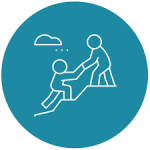Assignment Building of Memory
- From Business, General Business

- Academia
- Rating : 60
- Grade : A+
- Questions : 0
- Solutions : 4595
- Blog : 1
- Earned : $25563.50

Building of Memory: Managing Creativity Through Action
Read the case study titled “Building of Memory: Managing Creativity Through Action” before starting this assignment.
Review the Week 10 Individual Assignment in which you develop a Personal Leadership Plan.
Write a four to five (4-5) page paper in which you:
- Suggest three (3) specific change management techniques that Shimon Kornfield should have used in order to manage the morale of the team assigned to the Yad Vashem memorial site project.
- Outline the essential steps that Shimon Kornfeld could have taken in order to ensure that all team members learned of any proposed changes. Provide the rationale and justification for each step outlined.
- Assess the criticality of the timing of communication in the success of the Yad Vashem memorial site project. Support the response with three (3) specific examples.
- Assume that two (2) key members of the team were replaced during the executing phase of the Yad Vashem memorial site project due to family crises. Discern actions Shimon Kornfield could take in order to establish trust and gain credibility with the remaining project participants.
Your assignment must follow these formatting requirements:
- Be typed, double spaced, using Times New Roman font (size 12), with one-inch margins on all sides; citations and references must follow APA or school-specific format. Check with your professor for any additional instructions.
- Include a cover page containing the title of the assignment, the student’s name, the professor’s name, the course title, and the date. The cover page and the reference page are not included in the required assignment page length.
by Alexander Laufer, Zvi Ziklik, and Jeffrey Russell
Initial Stages: Making Progress by Splitting
Yad Vashem is a memorial site to the six million Jews killed by the Nazis. The 45-acre site located near Jerusalem contains several museums and various research and educational centers. The largest museum on site is the new Holocaust History Museum, which opened in March 2005. The architect of this museum, Moshe Safdie, who is a leading international designer, concludes his book Yad Vashem—The Architecture of Memory as follows:
· “No design I have ever undertaken was so charged with symbolic associations. It seemed that every move, form, shape, and sequence elicited multiple interpretations and endless debate. Now that the public has possessed the complex, I am amazed at the diversity of interpretations and reactions. When I am there, I often become a voyeur and watch visitors’ reactions and listen to their conversations. I have always wondered if architecture is capable of evoking the same emotions that we experience listening to music. At Yad Vashem, I am constantly aware of how intensely personal the feelings provoked are and how individual and particular. It is at these moments that I feel architecture can, however rarely, move us as deeply as music can.”
Shimon Kornfeld, the project manager of the Holocaust History Museum, recalls another kind of music that prevailed when he was appointed to lead the project from the early stages of the design. Loud voices and even shouting were known to accompany the passionate and intense debates about the fundamental concepts of the design that constantly took place between the chief curator of the museum, Avner Shalev, and the architect Moshe Safdie.
Shimon was already an experienced project manager at the time and was used to internal conflicts in his project teams. Over the years, he had learned to appreciate such conflicts because of their eventual positive impact on the quality of the team’s decisions. But this time was different. These conflicts often sounded more like a competition between two fierce opponents rather than a healthy debate between two members of the same team. Shimon was worried that such rivalry would hurt collaboration between the other members of the project team and that it would eventually hamper project progress. It was also difficult to reconcile diverging opinions in an analytical way because at this creative stage of the project, most decisions were based more on ideas and less on facts. Shimon realized that navigating between these two strong personalities and their respective teams would require a great deal of creativity on his own part as well.
It should be noted that both the chief curator and the architect enjoyed a unique and powerful status in the project. Avner, the chief curator, also served as chairman of the Yad Vashem Directorate of the Holocaust Martyrs’ and Heroes’ Remembrance Authority. That is, he was a member of the project team and head of the client organization at the same time. Safdie, who is regarded as a world renowned architect, had been awarded this project through an international competition, and his proposal had been selected by an independent committee composed of highly esteemed experts and public figures.
Thus, Shimon, the project manager, could not have dealt with these two designers like he would have any other member of the project team. They were simply too powerful. Because of the nature of this project—remembering the Holocaust—both designers were totally committed to the success of the mission, but each one felt that the other side was somehow attempting to “own” the entire project. The concern on the curators’ side was that the spectacular design of the building would be so dominant that it would stand by itself as a memorial and would overshadow the central role of the exhibitions. Ironically, therefore, the unique shape of Safdie’s structure worrying the curators was the very reason that his design had been chosen.
The truth is that Shimon himself was also very concerned about the design of the structure:
· “The museum’s central bloc was designed as a prism that penetrates into the ground and ‘erupts’ from it, at varying angles, as an unsupported protrusion. The walls of the prism envelope had a unique architectural design based on ‘exposed concrete’ elements with no external cladding or coating. We were worried that certain components of this unique and extraordinary monument might be impossible to execute.”
The architect explained his radical demands:
· “I was determined to cast the entire museum monolithically, jointless, unadorned—without any exterior waterproofing or cladding or any interior insulation or finishes. I wanted just the basic structure—concrete walls and floors and glass to let the light in from above.”
Thus, it is no surprise that Shimon came to the following conclusion: “The contractor will be required to ‘sculpt’ the concrete elements in order to realize the architect’s wild dream.” Shimon approached an expert in executing complex elements made of “architectural concrete” and asked him to examine the feasibility of executing the proposed design. The expert provided a list of recommendations to render the execution more feasible, but only a few of his recommendations were accepted by Safdie.
Safdie reiterated his opinion that the project must be imparted with a unique character and that he himself, as well as other leading architects around the world, had designed buildings of similar character that had been successfully executed and that served as a source of inspiration and a place of pilgrimage. In an attempt to convince Shimon, Safdie suggested that they visit a few of these sites abroad. Undertaking this tour, however, did not alleviate Shimon’s concerns: “On the tour, we saw structures that were amazing in their complexity, but the structure designed for Yad Vashem seemed to me to be more problematic than they were. I really did not know how one can build the external envelope of this unique building.”
Even the director general of Yad Vashem, Ishai Amrami, was not fully satisfied with the design of the building: “During the project, I had some harsh arguments with Shimon and with Shimon’s predecessor about the management of the design and particularly about our proceedings vis-á-vis Safdie. I felt that they avoided confrontations with the famous architect and in several cases, chose to ‘sacrifice’ the functionality of a certain area for the ‘benefit’ of an ‘architectural whim.’” Still, despite some discomfort on the part of the client, the curators, and the project manager with some aspects of the design, the architect seemed to have the power and the determination to stick to his design.
Although the new Holocaust History museum was the heart of the new development at Yad Vashem, it was only one component of it. The project that Shimon was managing was much larger and covered additional buildings and infrastructure work throughout the Yad Vashem site. The cost of the entire project was estimated at 100 million dollars, but at that time only 45 million dollars had already been procured. Given that the estimated cost of the museum building was about 40 million dollars, Ishai requested that Shimon split the construction of the museum building from the rest of the project and issue the tender for it as early as possible:
· “I was aware that the design of the electrical, mechanical, and other systems in the building had not been completed. However, Yad Vashem finances all its projects from donations, and accelerating the beginning of construction was crucial for obtaining financing for the project. Potential donors tend to respond more favorably to our appeals when they can see real action on site and when the actual structure starts rising on the site.”
Surprisingly, Shimon responded favorably to Ishai’s request. Even with the difficulties of starting construction on the building before design of all the systems was complete, Shimon felt that creating a fait accompli would put a quicker end to the bitter conflict between the curators and the architect. Moreover, Shimon explained that decoupling the building of the museum from the rest of the project would allow him and his team to focus all their attention on execution of the most difficult component of the entire project, the one with the radical design and stringent requirements. Thus, the gap in needed resources and the splitting process unexpectedly turned out to be a huge help for Shimon, enabling him to cope better with the many unique challenges posed by execution of the design.
[Solved] assignment Building of Memory
- This solution is not purchased yet.
- Submitted On 23 Aug, 2016 07:05:53

- Academia
- Rating : 60
- Grade : A+
- Questions : 0
- Solutions : 4595
- Blog : 1
- Earned : $25563.50


Week 6 Assignment - Infrastructure Design

NURS 6640N Week 4 Assignment 1

Liberty University ENGL 101 Mindtap 6 assignment complete solutions correct answers updated

Liberty University ENGL 101 Mindtap 2 assignment complete solutions correct answers updated

B6028 Module 4 Assignment 2 Internal Environmental Scan Organizational Assessment
The benefits of buying study notes from CourseMerits

Assurance Of Timely Delivery
We value your patience, and to ensure you always receive your homework help within the promised time, our dedicated team of tutors begins their work as soon as the request arrives.
Best Price In The Market
All the services that are available on our page cost only a nominal amount of money. In fact, the prices are lower than the industry standards. You can always expect value for money from us.


